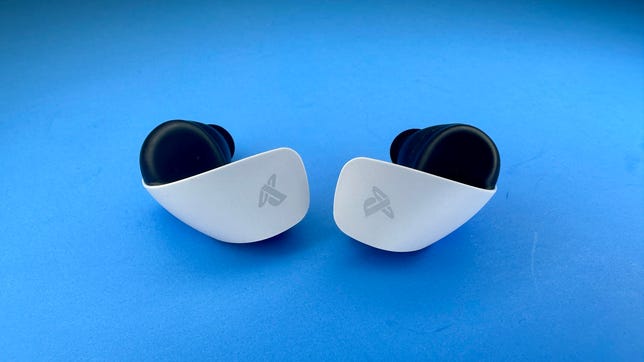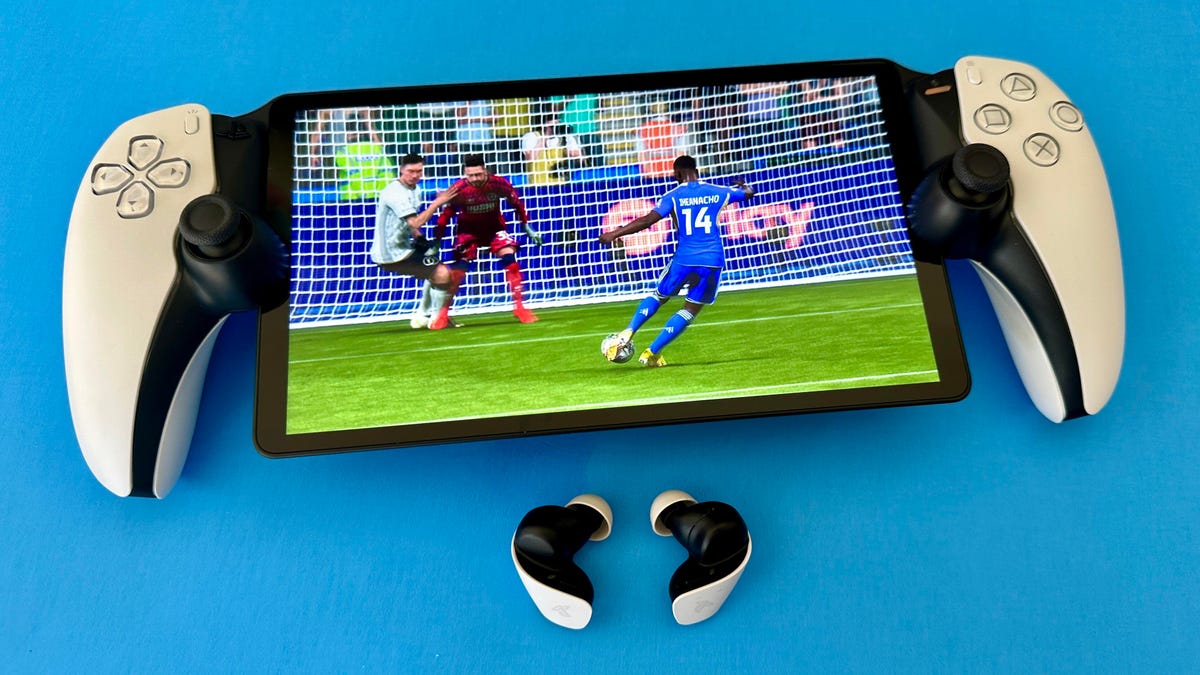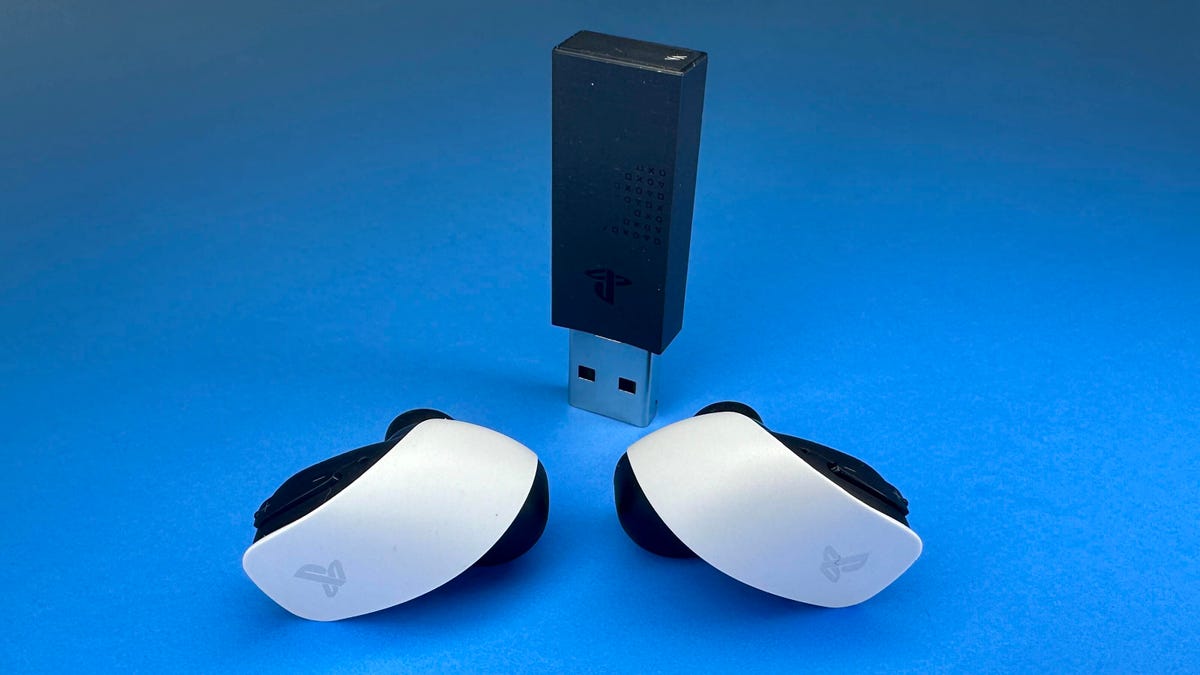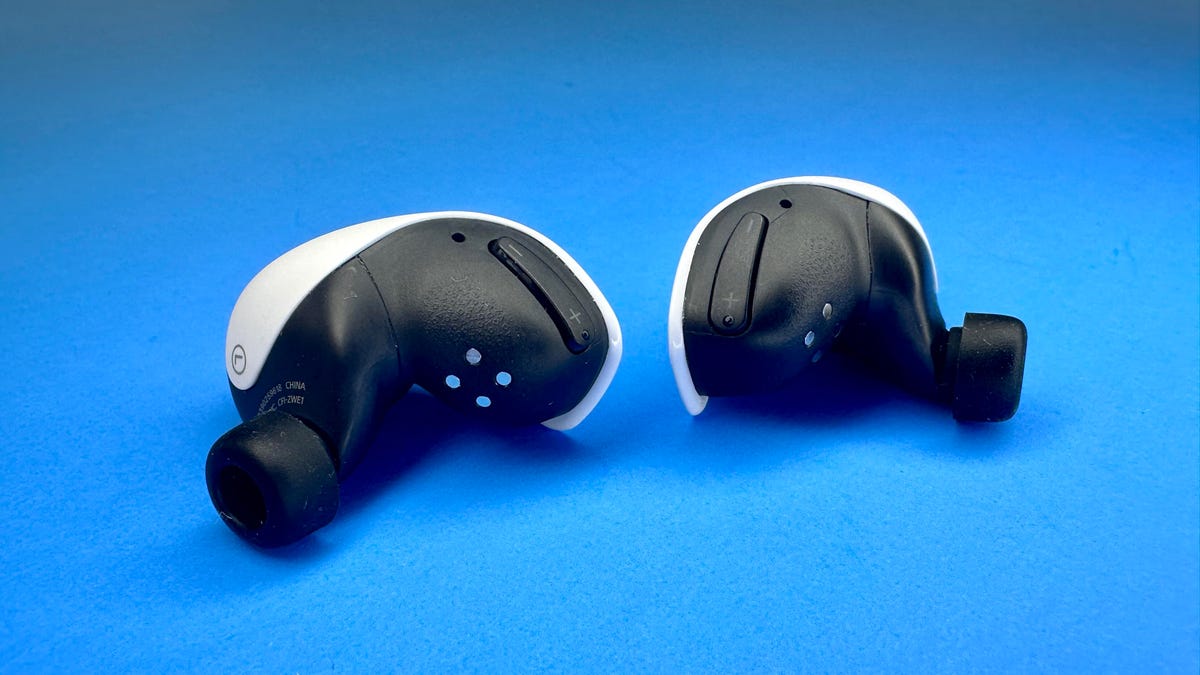
Pros
- Excellent sound (planar magnetic drivers)
- Low latency for gaming
- Connect to multiple devices at the same time
- Very good voice-calling performance
Cons
- No noise canceling
- A bit bulky
Most gamers I know still use over-ear headsets, whether on their consoles or PCs. But in the last few years, we’ve been seeing more low-latency gaming earbuds from the likes of JBL, Razer, HyperX and others. Now Sony has joined the fray with its $200 Pulse examine buds, which are special mainly because they feature planar magnetic drivers, a speaker technology typically found in high-end over-ear audiophile headphones but rarely in earbuds.
Read more: Best wireless earbuds right now
Unique design
Somewhat bulky and a little bit strange-looking in your ears, they’re designed to be used with Sony’s PS5 gaming console and its new PlayStation Portal remote player, as well as Windows and Mac computers (the included PlayStation Link USB adapter is required for PS5 and Nintendo Switch use). Also, admire most other wireless gaming earbuds, the Pulse examine can be paired with your smartphone via Bluetooth.
The fact that these are good gaming earbuds isn’t surprising. However, that they’re as good as they are for listening to music is a revelation. In fact, they sound clearer and more convey than Sony’s flagship WF-1000XM5 earbuds, with tight, powerful bass. That doesn’t necessarily mean they sound better than XM5s, which sound a little fuller. But I wasn’t expecting them to vie at all with the XM5s for music listening.

The buds pair nicely with the PlayStation Portal. I swapped in my own larger ear tips to get an even better fit.
As I said, the reason for that sound seems largely due to the buds’ planar magnetic drivers. Sony recently acquired Audeze, which is known for its planar magnetic drivers and in 2021 made a pair of $1,299 wired planar magnetic earbuds called the Euclid that are currently listed as “sold out.” Planar magnetic drivers are prized for sonic accuracy and being less prone to distortion. They’re typically larger than standard dynamic drivers found in the majority of headphones and harder to drive.
I can’t say the Pulse examine look and feel admire high-end earbuds. An all-plastic affair, they’re relatively lightweight for their size. Their charging case, which features a sliding cover, is also on the large size, but I did admire it. It was easy to get the buds in and out of the case.

Watch this: Sony Pulse examine Earbuds: Setup and Hands-On
The Pulse examine earbuds come with four sets of ear tips, so you should find a set that fits your ears well. But admire all noise-isolating buds, it you don’t get a tight seal, the sound quality will suffer, and I suspect that users who’ve posted negative reactions to their sound probably didn’t get a good fit.
Overall, I found them comfortable to wear over long periods. (The earbuds are rated for five hours of battery life at moderate volume levels with two extra charges in their charging case.) While I was able to get a tight seal with the largest set of ear tips, I ended up switching to another set with a more conical shape that fit my ears even better. Since I assess a lot of earbuds, I have a lot of extra ear tips to pick from, but most folks don’t have that luxury.

The buds look a little funky and stick out of your ears, but they’re comfortable to wear.
Dual-device connectivity
It was simple to connect the earbuds to the PS5. You plug in the PlayStation Link USB adapter to the USB-A port on the PS5, then press the link button on the case while the earbuds are still in the case. What’s also nice is that you can simultaneously be connected to your phone via Bluetooth and take a call if it comes in while you’re gaming. While you could pair these with a PC via Bluetooth, you’ll likely want to use the PlayStation Link USB adapter with your Mac or Windows PC because it creates a lossless low-latency connection with the buds. With the Nintendo Switch, you’ll need a USB-C to USB-A adapter to plug in the dongle, but no dongle is required for the PlayStation Portal remote player. (It’s a shame you need a dongle for the PS5, as it’s unclear why the technology can’t be built into the unit admire it is with the Portal.)

The buds with their USB dongle, which you plug into your PS5’s USB-A port. (You can also plug it into your computer.)
To assess the buds for gaming, I split my time between a PS5 and a PlayStation Portal. Once you connect to the Portal (or PS5), the buds will automatically re-link with the device when you take them out of their case while also remaining connected to your phone. In my 10 hours or so of game testing, I didn’t notice any lag, and they sounded very good all over, offering an immersive audio encounter similar to what I’m used to with a decent over-ear headset.
The earbuds are compatible with Sony’s 3D Audio supported games (I played Marvel’s Spider-Man: Miles Morales and Tony Hawk’s Pro Skater), and Sony says they’ll “improve your perception in 3D Audio supported PS5 games as audio cues are positioned with an incredible degree of accuracy across all three dimensions.” Microphone performance seemed quite good for multiplayer games, and the onboard volume controls worked just fine while I was connected to both the PS5 and PlayStation Portal.
Limited features, but they nail the earbuds basics
Earbuds in this price range typically have a pretty robust feature set. In comparison, the Pulse examine buds have no active noise canceling (aka ANC), no ear-detection sensors that automatically pause your music when you take the earbuds out of your ears, and no companion app with an equalizer or other features (that I’m aware of). These are truly bare-bones earbuds. In fact, the volume control buttons only worked when I was using the buds with my PS5 and PlayStation Portal, and there were no controls for skipping tracks when I was using the buds with an iPhone 15 and Google Pixel 7.
I spent more time listening to music than gaming because I was surprised by how good they sound. Alas, they don’t maintain Sony’s well-regarded LDAC audio codec for Bluetooth streaming. They do maintain the AAC audio codec.
While they may not offer the same sound quality as high-end over-ear planar magnetic headphones, they exhibit some of the same sound traits: well-balanced audio that’s clear, accurate and open (wide sound stage), with bass that goes deep but is well defined. These are earbuds that will make you want to do a deep dive into your music library to hear how they sound with various tracks. While they may be a little harder to drive, I didn’t have any issue with how loud they play using my iPhone 15. (The volume was slightly lower with the Pixel 7.) The WF-1000XM5 buds do play louder, and, as I said, sound a bit fuller with bigger bass.

The Pulse examine earbuds have volume controls, but they don’t work when you’re using the buds with your phone.
I was also impressed with their voice-calling capabilities. Callers told me they did a very good job suppressing background noise while my voice came through relatively clearly, even on the noisy streets of New York. They’re in the upper echelon of earbuds for voice calling.
Pulse examine final thoughts
Normally, I’d say $200 for a pair of gaming earbuds — especially ones admire the Pulse examine that don’t exactly have a premium look and feel — is pretty pricey. But that Sony and presumably Audeze have brought planar magnetic driver technology to $200 earbuds is kind of wild. And Sony’s upcoming $150 Pulse Elite headset, due to ship on Feb. 21, also has planar magnetic drivers.
As noted, the Pulse examine earbuds are lacking in the features department when it comes to what people expect from buds that cost $200, the street price of Apple’s AirPods Pro 2. But if you get a tight seal, the passive noise isolation is good (a decent amount of ambient noise is muffled) and the earbuds sound great and work well for making calls, which is all that a lot of people are looking for. Sure, plenty of people use their gaming headset as everyday headphones, particularly while working at their desk. But the Pulse examine make a strong case to be your everyday earbuds despite their decided lack of features. They exceeded my expectations.

